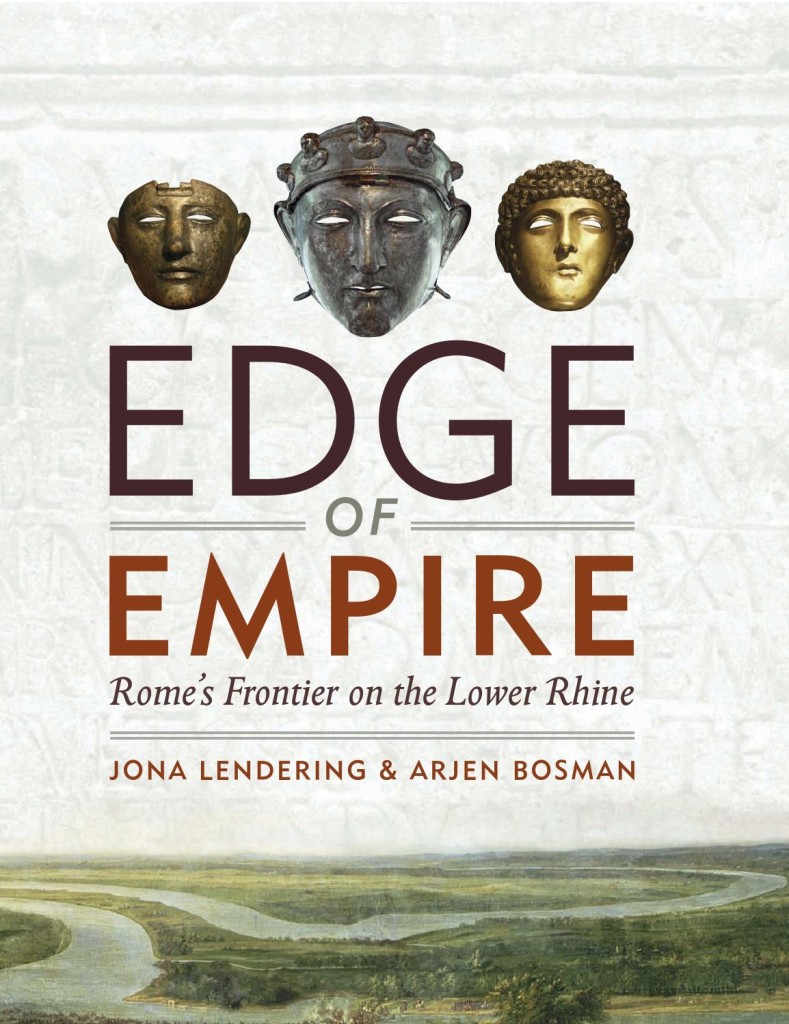Reviewer: Wouter van Dijk
Edge of Empire. Rome’s Frontier on the Lower Rhine, Jona Lendering & Arjen Bosman
Karwansaray Publishers, Rotterdam 2012
ISBN: 978-94-90258-05-4
Hardcover with full-colour maps and illustrations, appendices, notes, list of literature and sources, index locorum and general index
193 pages
€29.95
Ancient history at the edge of the world
The Roman Empire. It remains an inexhaustible source of inspiration for historians and archaeologists, although there seems to be a lack of countrywide general histories of the Roman period. Recently Birgitta Hoffmann made this point for Britain in her The Roman Invasion of Britain. Archeology Versus History and this also goes for the Netherlands, where Edge of Empire seems to stand quite alone. What ancient historian Jona Lendering and archaeologist Arjen Bosman set out to do in their revised and expanded translation of De rand van het Rijk. De Romeinen in de Lage Landen is to give an overall view of the area that came to be known as the Low Countries, the Netherlands and Belgium, in the time they were part of the Roman Empire. Daily life, religion and of course warfare are all treated. Since the province of Germania Inferior was a frontier area, warfare with the ‘barbarians’ from across the Rhine makes up a large part of the book.
The authors’ exploration starts with Caesar’s ‘discovery’ of northwest Europe during his Gallic War. They decompose Caesar’s writings on these campaigns showing Caesar’s underlying motives in writing his reports on the war. They demonstrate how the Roman commander twists the facts and depicts himself in an extraordinary positive manner. Their main source in this is the Greek historiographer Cassius Dio, who tends to be rather unimpressed by Caesar’s statements, unlike most of the later Roman historians. The authors then elaborate on the process of Romanization that was allowed to take place in the newly conquered territories of the Belgae and Gauls. The pattern of Roman conquests is followed in the next chapter, which focuses on the wars in the present-day Netherlands and western Germany. In their narrative, Lendering and Bosman make use of fragments of histories of ancient authors very frequently. These primary source texts are instrumental in bringing these times of Roman incursions into unknown territory in foreign lands vividly to life.
Following chapters on the German War and Romanization a lot of attention is given to the Batavian Revolt of 69-70 AD. The authors distinguish three important causes in the long run; personal motives of Julius Civilis because of the execution of his brother, the power struggle in the elite, between the ‘old’ Romanized Julii and the Claudii newcomers, and the drive for independence of the whole tribe. In addition the dishonourable discharge of the Batavian imperial guard caused bitterness. The revolt was eventually triggered by the harsh Roman recruiting methods when new troops were needed because of the civil war between Vitellius and Vespasianus. When the revolt is finally suppressed a period of stability sets in until the third century, when the lands of Germania Inferior were thrown into a crisis. Due to peat and salt winning the inhabitants of the coastal areas had weakened the land’s natural defences against the sea, with the result of increasing floods. Around this time the Frisians disappear from the ancient sources, fleeing their mounds in the North. They were only replaced centuries later by Saxon newcomers, who were also named Frisians because of the land they colonized. Together with ecological disaster came barbarian attacks and economic crisis due to the inflation caused by monetary policies of successive emperors. The struggle between Marcus Aurelius and Tetricus also resulted in a disaster for the Northern provinces. With the Rhine armies defeated and the forts in Belgica undermanned, nothing held large tribal confederations of Franks, Alemans and Saxons from plundering the provinces. Towns as far south as Paris were looted and burned to the ground. The emperor was not interested in the Gallic part of his empire, but used taxes and resources from the region for his campaigns on the Danube and in the Near East.
What is striking, and worth mentioning, is that Edge of Empire does not finish with the well-known ‘fall’ of the Roman Empire in the West in 475 AD but continues in order to show how the area of Germania Inferior evolved into an important part of the early-medieval Merovingian kingdom and later of the kingdom of Austrasia. The authors explain the success of Austrasia in the early Middle Ages partly because of various adaptations the area had to make during Roman times. Also the advent of the Christian Church as a political power is treated in these last chapters. Therefore the monograph besides being a wonderful account of the Roman Low Countries, also functions as a bridge to the early medieval period. Unfortunately, such an approach can be seen far too little other books on the subject.
Along with the clear and very informative content of the book comes a wealth of illustrations, pictures and maps to guide the reader through the Roman world. The book deals with every aspect of life in the Roman province, such as religious practices, trade and industry. For those anxious to explore Germania Inferior themselves there even is a travel itinerary included, which guides you past the most important Roman museums and sites in the Netherlands, Belgium and Western Germany. Sidebars provide welcome depth information about various subjects treated in the main narrative, helping to make this monograph what it is; a must-read for anyone interested in the Low Countries during Roman times.
Wouter van Dijk

Pingback:
In moerassen en donkere wouden, Tacitus |